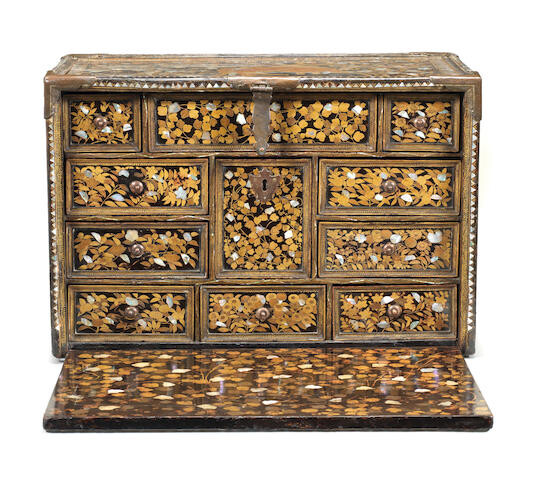A RARE GILT-COPPER-MOUNTED SHELL-INLAID NANBAN LACQUER CABINET
Momoyama Period, late 16th/early 17th century
Momoyama Period, late 16th/early 17th century
Embellished predominantly in gold hiramaki-e lacquer and inlaid with shell, the single-hinged door decorated on the front with a ho-o (phoenix) and a smaller bird standing on a rock among flowering peony and kikyo (Chinese bellflowers), three other birds in flight, the top surface with a pair of four-tusked elephants resting among tall stems of kikyo, plum blossoms and pine; the right side with a bird of prey about to attack one of two smaller birds, one perched on a maple tree; the left side with a pair of monkeys gripping trailing branches of wisteria; the back with meandering branches of clematis; the door opening downwards to reveal an interior panel decorated with meandering branches of kuzu (kudzu vine), and eleven drawers of four sizes decorated with assorted floral designs including camellia, fruiting orange tachibana and nogiku (wild chrysanthemums), all arranged horizontally in four rows and fitted with a gilt-copper chrysanthemum knop surrounding a central drawer fitted with a copper lock plate, all framed by narrow thin bands of gold lacquer zig-zag motifs, the sides with two copper-gilt carrying handles, the corners applied with gilt-copper fittings engraved with stylised cherry, the underside undecorated; with the original key. 64cm (25 1/8in) wide x 43.5cm (17 1/8in) high x 34cm (13½in) deep. (2).
日本桃山時代,十六世紀晚期/十七世紀早期 花鳥獣蒔絵螺鈿洋櫃
Provenance: an important European private collection
來源:歐洲重要私人收藏
Crafted in Kyoto's lacquer workshops alongside quite different wares intended for elite Japanese clients, these kinds of Nanban coffers and cabinets decorated in gold hiramaki-e and shell were among the earliest Japanese artefacts to reach Asian and European markets, starting two or three decades after the first landfall by Portuguese adventurers in the mid-sixteenth century. Celebrated today for their lavish, innovative technique and dense ornamentation (inspired in part by wares from other parts of Asia), such pieces brought the Japanese genius for design to global attention and ensured that Japan would be synonymous with 'lacquer' until the present day.
Traded along newly-opened global sea routes, Japanese lacquers offered Asian and European monarchs alike a distant glimpse of the splendours of the Momoyama age, when great warlords like Toyotomi Hideyoshi (1537–1598) took overall control of the country. Hideyoshi and his rivals, vassals and successors ordered lavish use of gold—not just on lacquer wares but on folding screens and wall-painting ensembles as well—to brighten the brooding interior spaces of their magnificent palaces and castles.
The decoration of this splendid cabinet, with lively animal, bird and flower designs placed within rich floral and geometric ornament, points to a date during the closing years of the sixteenth century or the opening decades of the seventeenth, when such wares partially reflected contemporaneous pictorial trends within Japan.
For a discussion about Nanban fall-front cabinets of this type, illustrating comparative examples, see O.Impey and C.J.A.Jörg, Japanese Export Lacquer 1580-1850, Amsterdam, 2005, pp.122-124.
View it on
Sale price
Estimate
Time, Location
Auction House
Momoyama Period, late 16th/early 17th century
Momoyama Period, late 16th/early 17th century
Embellished predominantly in gold hiramaki-e lacquer and inlaid with shell, the single-hinged door decorated on the front with a ho-o (phoenix) and a smaller bird standing on a rock among flowering peony and kikyo (Chinese bellflowers), three other birds in flight, the top surface with a pair of four-tusked elephants resting among tall stems of kikyo, plum blossoms and pine; the right side with a bird of prey about to attack one of two smaller birds, one perched on a maple tree; the left side with a pair of monkeys gripping trailing branches of wisteria; the back with meandering branches of clematis; the door opening downwards to reveal an interior panel decorated with meandering branches of kuzu (kudzu vine), and eleven drawers of four sizes decorated with assorted floral designs including camellia, fruiting orange tachibana and nogiku (wild chrysanthemums), all arranged horizontally in four rows and fitted with a gilt-copper chrysanthemum knop surrounding a central drawer fitted with a copper lock plate, all framed by narrow thin bands of gold lacquer zig-zag motifs, the sides with two copper-gilt carrying handles, the corners applied with gilt-copper fittings engraved with stylised cherry, the underside undecorated; with the original key. 64cm (25 1/8in) wide x 43.5cm (17 1/8in) high x 34cm (13½in) deep. (2).
日本桃山時代,十六世紀晚期/十七世紀早期 花鳥獣蒔絵螺鈿洋櫃
Provenance: an important European private collection
來源:歐洲重要私人收藏
Crafted in Kyoto's lacquer workshops alongside quite different wares intended for elite Japanese clients, these kinds of Nanban coffers and cabinets decorated in gold hiramaki-e and shell were among the earliest Japanese artefacts to reach Asian and European markets, starting two or three decades after the first landfall by Portuguese adventurers in the mid-sixteenth century. Celebrated today for their lavish, innovative technique and dense ornamentation (inspired in part by wares from other parts of Asia), such pieces brought the Japanese genius for design to global attention and ensured that Japan would be synonymous with 'lacquer' until the present day.
Traded along newly-opened global sea routes, Japanese lacquers offered Asian and European monarchs alike a distant glimpse of the splendours of the Momoyama age, when great warlords like Toyotomi Hideyoshi (1537–1598) took overall control of the country. Hideyoshi and his rivals, vassals and successors ordered lavish use of gold—not just on lacquer wares but on folding screens and wall-painting ensembles as well—to brighten the brooding interior spaces of their magnificent palaces and castles.
The decoration of this splendid cabinet, with lively animal, bird and flower designs placed within rich floral and geometric ornament, points to a date during the closing years of the sixteenth century or the opening decades of the seventeenth, when such wares partially reflected contemporaneous pictorial trends within Japan.
For a discussion about Nanban fall-front cabinets of this type, illustrating comparative examples, see O.Impey and C.J.A.Jörg, Japanese Export Lacquer 1580-1850, Amsterdam, 2005, pp.122-124.



